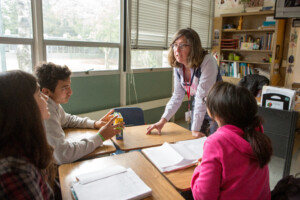State of the Union 2015 in Edu

With the attention of the nation and under the eye of a very divided House Chamber, political pageantry took center stage in Obama’s seventh State of the Union (SOTU) Address.
The annual event that ties us to our poli-historical past served as a platform for Obama to share his agenda, and a rallying point for political pundits and antagonists alike to judge his next 100 days, year in the office, and the Democrats’ chances in 2016. With the Republican controlled congress and the announcements by presidential candidates any day now, the emotion from the crowd couldn’t be more subdued.
Bookended by the story of a mother from Minneapolis who enrolled in community college as a way to retool after the 2009 recession, when it came to education, POTUS focused primarily on higher education and community college. K-12 was limited to brief mentions of access, connectivity, and opportunity.
Obama is the sixth lame duck president to take the podium for the SOTU who in every case has faced a congress controlled by the opposite party. For a congress who ran and won on the platform of getting things done, we anticipate POTUS to be more active, either signing or vetoing following his majority progressive agenda he shared on Tuesday night.
Two of our favorite Ed Quotes from POTUS:
“Update our job training system, we’re connecting community colleges with local employers to train workers to fill high-paying jobs like coding, and nursing, and robotics.”
“I intend to protect a free and open internet, extend its reach to every classroom, and every community – so that the next generation of digital innovators and entrepreneurs have the platform to keep reshaping our world.”
Here’s our takeaways from the night of pomp and ceremony on Capitol Hill.
Community college accessibility
“Put simply, what I’d like to do is to see the first two years of community college free for everyone who is willing to work for it. – It’s something that’ll train our workforce so we can compete with anyone in the world.”
“I am sending…Congress a bold new plan to lower the cost of community college—to zero” —Obama #SOTU pic.twitter.com/p5IhRSLgsg
— The White House (@WhiteHouse) January 21, 2015
In many cases, community college is already free or cheap for low-income learners who can navigate the application process. Making it free for those that can afford to pay won’t drive up graduation rates. What would help is better high school preparation and supports like subsidized living expenses and child care for adults in college. Struggling high school and college students need stronger guidance and personalized supports.
Postsecondary learning is no longer a one shot deal–employability is all about lifelong learning.
Postsecondary learning should start in high school–and we’ve seen great examples in the last two weeks:
- 80% of Quest ECHS students graduate with an AA degree
- Blue Valley CAPS students participate in emerging professions and gain college credit.
- RAMTEC high school students at Tri-Rivers Career Center learn robotics alongside college and adult learners.
Career-relevant postsecondary education should continue to be affordable, including learning alternatives such as code school. Online course provider Udemy CEO Dennis Yang said: “Learning is not only for higher education institutions, it’s important for adults, whether or not they attended college, to continually develop their professional skills.”
Student debt
“I want to work with this Congress, to make sure Americans already burdened with student loans can reduce their monthly payments, so that student debt doesn’t derail anyone’s dreams.”
Mentioned briefly at the end of POTUS’ community college proposal and as details in the story about the couple from Minneapolis was student debt.
“Too many bright, striving Americans are priced out of the education they need. It’s not fair to them” —Obama #SOTU #LeadOnEducation
— White House Live (@WHLive) January 21, 2015
Not addressed
ESEA
More than a decade overdue for an update, it’s time for congress to pass an reauthorization of the Elementary and Secondary Education Act (ESEA). In a recent statement, iNACOL urged support for Competency Education in ESEA reauthorization (see full white paper).
The iNACOL State Policy Frameworks: 5 Critical Issues to Transform K–12 Education suggests state support for competency-based learning, teacher leaders and next gen school models.
Read #SOTU: Building Capacity for the Future of U.S. Education, by Susan Patrick, President & CEO of iNACOL, who echoes the necessity to reauthorize ESEA. “iNACOL believes this will be core to the conversation we, as a nation, must have about the future of the U.S. public education system over the coming months,” said Patrick.
With the long awaited reauthorization of the No Child Left behind act, another K-12 issue not addressed, competency-based learning has significant potential to align the bill with a more relevant and effective model for learning.
FCC Act
We appreciate recent progress on e-Rate but think it’s also time to update the 1934 Communications Act as discussed in Modern Policy for Modern Learners.
New Tools & Schools
A key finding of Smart Cities That Work for Everyone was the need to incubate next gen learning.
NGLC, Getting Smart Advocacy Partner, grant programs have been very successful at spurring next gen learning. We chronicled the story of 15 teams in Lighting the Path to Personalized Learning (including a couple innovators in Brooklyn) the feds could provide a matching grant program for states and regions that want to create their own grant program.
We think work-based learning is important–particularly in technical and manufacturing fields. The feds could offer tax breaks for companies that offer significant internship opportunities to high school students (e.g., one 180 hour internship for every 50 employees).
IES, the research arm of the department could help solve the 7 problems we posed including strategies for combining formative assessment and measuring individual growth rates. This would help bring shrink (or end) week long summative assessments that have grown so unpopular.
IES could also provide more support for the investigation of the neuroscience of learning and the emerging field of learning experience design.
This year’s SOTU was the most interactive, and engaging SOTU address to date with the White House all in on social media with Tumblr, Twitter, Facebook, YouTube, and live streaming on White House Live, and the entire speech published before POTUS even took the podium.
Full video: Watch President Obama’s State of the Union address. #SOTU http://t.co/VeH9EzTFjd — The White House (@WhiteHouse) January 21, 2015
For more see on what it’s going to take to reinvigorate cities and citizens, check out:
- The Leadership it Takes to Create Smart Cities
- 10 Ways Cities Can Foster a Climate of Improvement and Innovation
Tyler Nakatsu is the Content Coordinator at Getting Smart. Find Tyler on Twitter at @post_west.









0 Comments
Leave a Comment
Your email address will not be published. All fields are required.